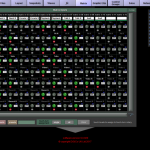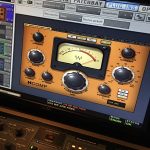Pushing Stuff Out of the Way
So, I’ve been thinking about compression a lot lately, although, that’s not really something new. Traditionally I’ve looked at a compressor as something you can do three categories of things with:
First up is good ole fashioned leveling. Depending on the circles you spend time in, some engineers talk these days like compressors aren’t good for this. However, basic leveling is why compression was invented. Well, probably more “limiting” than compression as it was originally intended for use in protecting broadcast equipment to keep from overmodulating radio transmitters.
When engineers discovered they liked what the compression did to the sound of things we got our next reason for using compression: envelope shaping. Once you figure out how to use a compressor to add punch to a drum, there’s no looking back. This is one of my favorite things to demonstrate when I’m training engineers as I still remember how much this changed the way I approached compression.
A third reason for using a compressor is closely linked to the last idea: tone shaping. Some compressors simply have a “sound”. You can think of this like adding a bit of salt or a spice to something. It’s not really about noticeably changing an inherent sound; it’s more like dressing it up a little. Some engineers describe this like it’s drastic tone-shaping, but to me it’s usually more subtle.
For example, something I’ve been doing on occasion is using a Fairchild plug-in emulation for tone. I’ve never been a fan of the Fairchild emulations for compressing things, and people used to look me funny when I’d tell them so I started keeping my mouth shut. Then I heard Bob Clearmountain bag on Fairchilds, and I’ve heard some other guys like Andrew Scheps share similar opinions. But Andrew Scheps did turn me on to what the Fairchild can do from a tonal perspective, and I’ve been liking that. So I don’t really use the Fairchild stuff for compression, but I do sometimes run stuff through it for the flavor it adds.
Within reasons 2 & 3 is also why I often use parallel compression on my drums. I get ’em punchier and a little fatter at the same time. But parallel compression is also how I come to a fourth reason for compression that has been occupying me:
Movement.
Calling this “movement” sounds artsy and hippy to me, but maybe an easier way I can describe what I’m talking about is “pushing stuff out of the way.”
Before I dig in on this, though, let me just say I would file this under more intermediate and advanced uses of compression. If you haven’t mastered the stuff above, this probably isn’t something you should be playing with yet.
In the three reasons to use compression listed above, most engineers’ first thought is to apply each concept to an individual instrument or input. But the movement I’m talking about largely comes from applying compression to multiple or “grouped” instruments. A first example of this is probably buss compression.
If we put a compressor on our master buss, the sounds with the highest levels at any given time are going to drive that compressor’s action. Generally what happens, though, is our drums–well, my drums anyway–drive a lot of the compressor’s action. So every time the drum hits, the compressor ducks everything down a bit which draws attention to the thing that ducked it all down in the first place: the drum.
But how about another example? Think about parallel compression a bit. I’ve been doing this for years, but I’ve only been understanding this better as of late. In the parallel compression I use on drums, I route all of my drums–kick, snare, and toms–to the parallel compressor. I did a recent video demonstrating this, but one of the things missing in that video is I also put the bass guitar in there.
When the bass guitar is playing all by itself, that parallel compressor doesn’t do much because the compression is really set up to work on the drums. So what I get is the bass running through my clean group adding with the bass running through my parallel compressed group to give me my overall sound and level of the bass in the mix. When I throw the drums into the equation, they get that compressor working, and result is the overall bass level gets attenuated a bit with each drum hit because its level is going down in the parallel buss when the compression kicks in on the drums. So in one sense, I’ve been using the parallel compression to duck the bass a bit and push it out of the way of the drums.
Here’s where the plot thickens and what I’ve been playing with. Think about how this pushing concept might be applied to the rest of the band. Andrew Scheps turned me on to this as it’s typically a big part of his mixes, although, it seems to be growing in popularity amongst a variety of studio cats. Scheps uses parallel compression on a buss with everything but the drums in it, although, I’ve seen him put those in there at times, too.
What happens is you have all this musical content driving that parallel buss so as things poke up a little, the compressor works in response adding subtle movement to the whole thing by driving all the other stuff down a bit in places. For example, when the vocal comes in it pushes the instrumentation down a bit with it, and then the instrumentation rises back in the breaks. Depending on the compressor you use, you might also get a bit of added color in the mix.
In some ways this auto-mixes things, although, it’s not a magic bullet by any stretch. As I’ve played around with this in my studio, I’ve continued to ride things here and there throughout a mix. Where I find a difference, though, is this helps me bring everything together a little faster. Below is a recent mix I’ve been putzing around with as I’ve been refine this technique a bit. Thanks to Softube and Mix With the Masters for the stems. If can’t see the embed on the website, you can check it out HERE.
While part of my experimentation with this has been for work in my studio, I’ve also been trying to figure out how to port it to the live world. One of the big concepts in my audio classes and workshops is time management, so I’m always looking for things that will speed up the process while improving results, and this fits that bill for me. Porting this isn’t so easy, though, as it took some effort to set it up in my studio. The routing was easy, but the challenge was getting it to work how I wanted it.
First up was getting the compressor behavior where I wanted it. I don’t think this is a type of parallel compression technique that works quite the same when you bring it in late in the game. So its contribution to the overall mix needs to be happening right from the start, and you need to mix into it. The problem is, at first you don’t know how much it will contribute to the overall level. So you can’t just put a vocal into the mix, then dial in the parallel compression, and then bring the compression up. You need to put some vocal in, turn on some compression, bring the parallel up, and then keep repeating it until you have the right overall level in the mix. It seems like something that should be easy to do, but it took a bunch of trial and error to get things where I was happy, and the time to do that live isn’t something I have a lot of these days.
The other thing I’m concerned with is gain before feedback and ambient bleed in open mics. I don’t work the parallel compressor exceedingly hard, but I do get it working so I’m concerned about what will happen when it releases from a vocal. Since the vocals tend to push it the most, the release will bring up the ambiance a bunch and potentially put mics into feedback. The next step is probably to try the technique out using some live tracks to see about bleed, but the gain before feedback thing could render this a moot concept.
Have you ever played around with parallel compression on the whole band in a live setting? I’d love to hear about your experiences in the comments.

 Previous Post
Previous Post Next Post
Next Post


